HLTA Project: Communication and Positive Relationships - Unit One
VerifiedAdded on 2023/06/18
|9
|3145
|88
Homework Assignment
AI Summary
This assignment is an HLTA (Higher Learning Teaching Assistant) course project focusing on Unit One, which covers communication and positive relationships. It addresses key aspects such as the difference between open and closed questions, the importance of reflective listening, barriers to effective communication (physical, emotional, cultural, language, and gender), and the significance of working within one's job description. The project further explores examples of anti-social behavior in a classroom setting, how an HLTA can support students exhibiting such behavior, and strategies to prevent unjustified discriminatory behavior. It also highlights essential aspects of effective communication, the purpose of a Behavior Support Plan (BSP), and key considerations for building effective relationships. The aim is to provide a comprehensive understanding of effective communication strategies and relationship-building techniques within an educational environment.
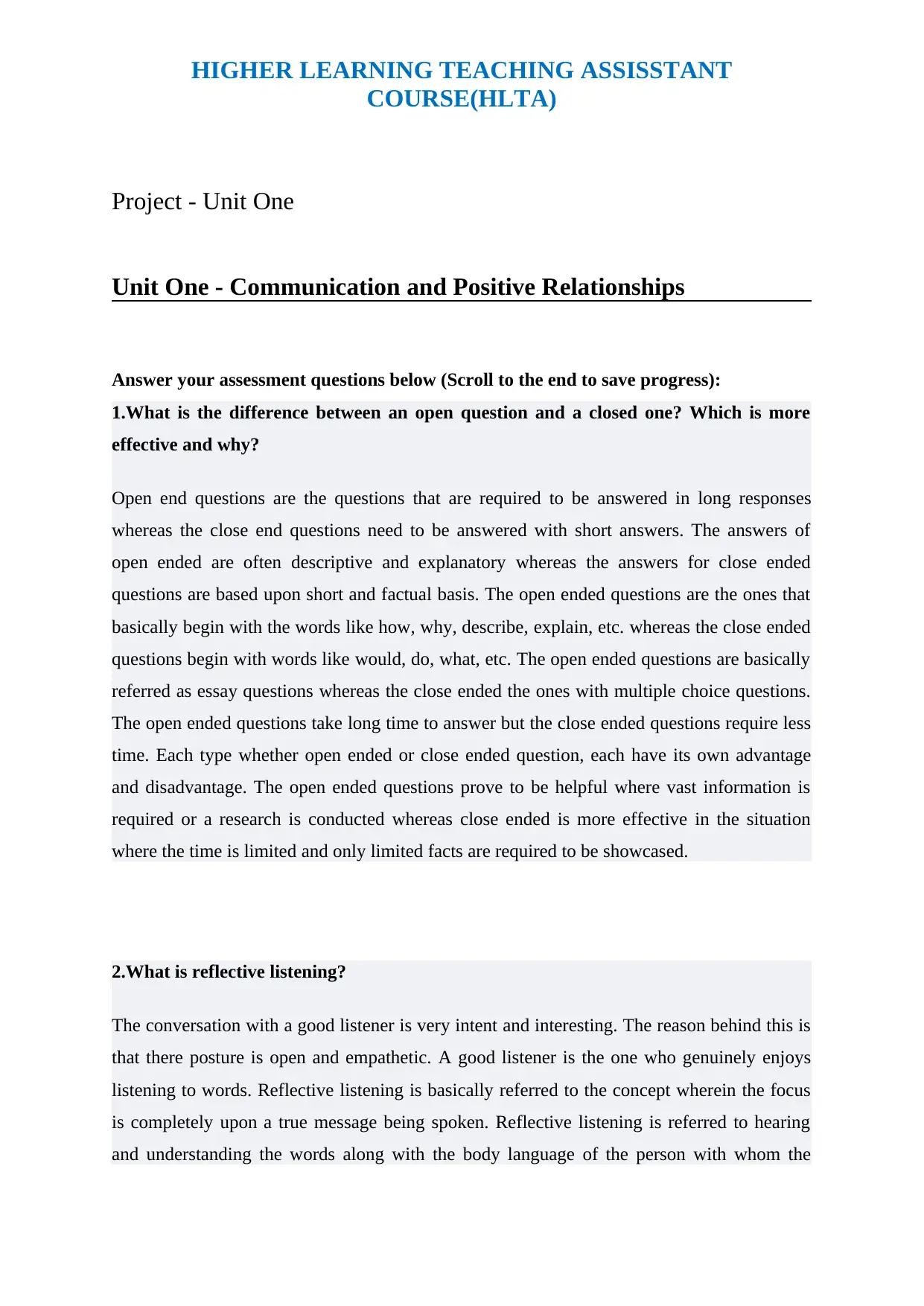
HIGHER LEARNING TEACHING ASSISSTANT
COURSE(HLTA)
Project - Unit One
Unit One - Communication and Positive Relationships
Answer your assessment questions below (Scroll to the end to save progress):
1.What is the difference between an open question and a closed one? Which is more
effective and why?
Open end questions are the questions that are required to be answered in long responses
whereas the close end questions need to be answered with short answers. The answers of
open ended are often descriptive and explanatory whereas the answers for close ended
questions are based upon short and factual basis. The open ended questions are the ones that
basically begin with the words like how, why, describe, explain, etc. whereas the close ended
questions begin with words like would, do, what, etc. The open ended questions are basically
referred as essay questions whereas the close ended the ones with multiple choice questions.
The open ended questions take long time to answer but the close ended questions require less
time. Each type whether open ended or close ended question, each have its own advantage
and disadvantage. The open ended questions prove to be helpful where vast information is
required or a research is conducted whereas close ended is more effective in the situation
where the time is limited and only limited facts are required to be showcased.
2.What is reflective listening?
The conversation with a good listener is very intent and interesting. The reason behind this is
that there posture is open and empathetic. A good listener is the one who genuinely enjoys
listening to words. Reflective listening is basically referred to the concept wherein the focus
is completely upon a true message being spoken. Reflective listening is referred to hearing
and understanding the words along with the body language of the person with whom the
COURSE(HLTA)
Project - Unit One
Unit One - Communication and Positive Relationships
Answer your assessment questions below (Scroll to the end to save progress):
1.What is the difference between an open question and a closed one? Which is more
effective and why?
Open end questions are the questions that are required to be answered in long responses
whereas the close end questions need to be answered with short answers. The answers of
open ended are often descriptive and explanatory whereas the answers for close ended
questions are based upon short and factual basis. The open ended questions are the ones that
basically begin with the words like how, why, describe, explain, etc. whereas the close ended
questions begin with words like would, do, what, etc. The open ended questions are basically
referred as essay questions whereas the close ended the ones with multiple choice questions.
The open ended questions take long time to answer but the close ended questions require less
time. Each type whether open ended or close ended question, each have its own advantage
and disadvantage. The open ended questions prove to be helpful where vast information is
required or a research is conducted whereas close ended is more effective in the situation
where the time is limited and only limited facts are required to be showcased.
2.What is reflective listening?
The conversation with a good listener is very intent and interesting. The reason behind this is
that there posture is open and empathetic. A good listener is the one who genuinely enjoys
listening to words. Reflective listening is basically referred to the concept wherein the focus
is completely upon a true message being spoken. Reflective listening is referred to hearing
and understanding the words along with the body language of the person with whom the
Paraphrase This Document
Need a fresh take? Get an instant paraphrase of this document with our AI Paraphraser
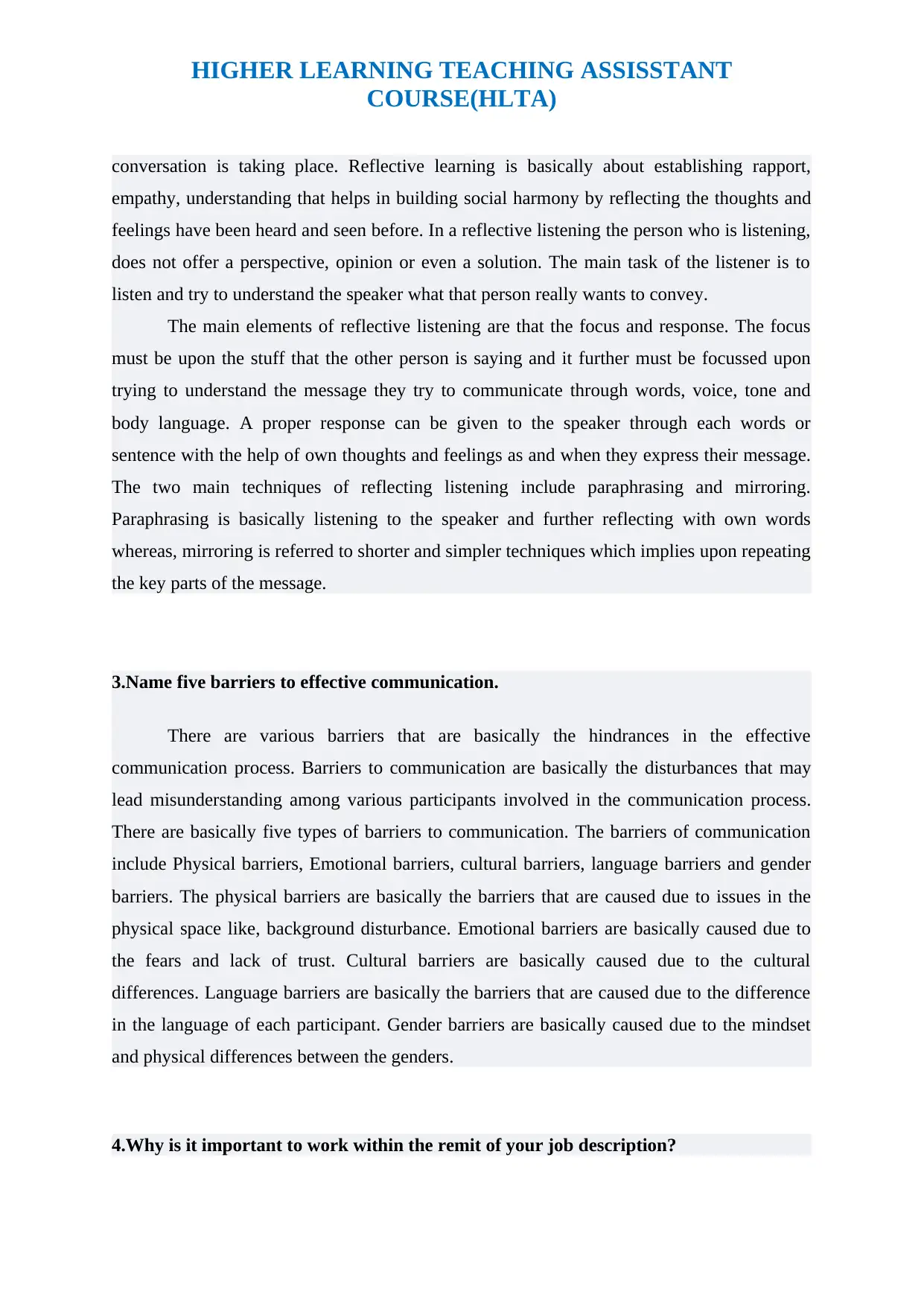
HIGHER LEARNING TEACHING ASSISSTANT
COURSE(HLTA)
conversation is taking place. Reflective learning is basically about establishing rapport,
empathy, understanding that helps in building social harmony by reflecting the thoughts and
feelings have been heard and seen before. In a reflective listening the person who is listening,
does not offer a perspective, opinion or even a solution. The main task of the listener is to
listen and try to understand the speaker what that person really wants to convey.
The main elements of reflective listening are that the focus and response. The focus
must be upon the stuff that the other person is saying and it further must be focussed upon
trying to understand the message they try to communicate through words, voice, tone and
body language. A proper response can be given to the speaker through each words or
sentence with the help of own thoughts and feelings as and when they express their message.
The two main techniques of reflecting listening include paraphrasing and mirroring.
Paraphrasing is basically listening to the speaker and further reflecting with own words
whereas, mirroring is referred to shorter and simpler techniques which implies upon repeating
the key parts of the message.
3.Name five barriers to effective communication.
There are various barriers that are basically the hindrances in the effective
communication process. Barriers to communication are basically the disturbances that may
lead misunderstanding among various participants involved in the communication process.
There are basically five types of barriers to communication. The barriers of communication
include Physical barriers, Emotional barriers, cultural barriers, language barriers and gender
barriers. The physical barriers are basically the barriers that are caused due to issues in the
physical space like, background disturbance. Emotional barriers are basically caused due to
the fears and lack of trust. Cultural barriers are basically caused due to the cultural
differences. Language barriers are basically the barriers that are caused due to the difference
in the language of each participant. Gender barriers are basically caused due to the mindset
and physical differences between the genders.
4.Why is it important to work within the remit of your job description?
COURSE(HLTA)
conversation is taking place. Reflective learning is basically about establishing rapport,
empathy, understanding that helps in building social harmony by reflecting the thoughts and
feelings have been heard and seen before. In a reflective listening the person who is listening,
does not offer a perspective, opinion or even a solution. The main task of the listener is to
listen and try to understand the speaker what that person really wants to convey.
The main elements of reflective listening are that the focus and response. The focus
must be upon the stuff that the other person is saying and it further must be focussed upon
trying to understand the message they try to communicate through words, voice, tone and
body language. A proper response can be given to the speaker through each words or
sentence with the help of own thoughts and feelings as and when they express their message.
The two main techniques of reflecting listening include paraphrasing and mirroring.
Paraphrasing is basically listening to the speaker and further reflecting with own words
whereas, mirroring is referred to shorter and simpler techniques which implies upon repeating
the key parts of the message.
3.Name five barriers to effective communication.
There are various barriers that are basically the hindrances in the effective
communication process. Barriers to communication are basically the disturbances that may
lead misunderstanding among various participants involved in the communication process.
There are basically five types of barriers to communication. The barriers of communication
include Physical barriers, Emotional barriers, cultural barriers, language barriers and gender
barriers. The physical barriers are basically the barriers that are caused due to issues in the
physical space like, background disturbance. Emotional barriers are basically caused due to
the fears and lack of trust. Cultural barriers are basically caused due to the cultural
differences. Language barriers are basically the barriers that are caused due to the difference
in the language of each participant. Gender barriers are basically caused due to the mindset
and physical differences between the genders.
4.Why is it important to work within the remit of your job description?
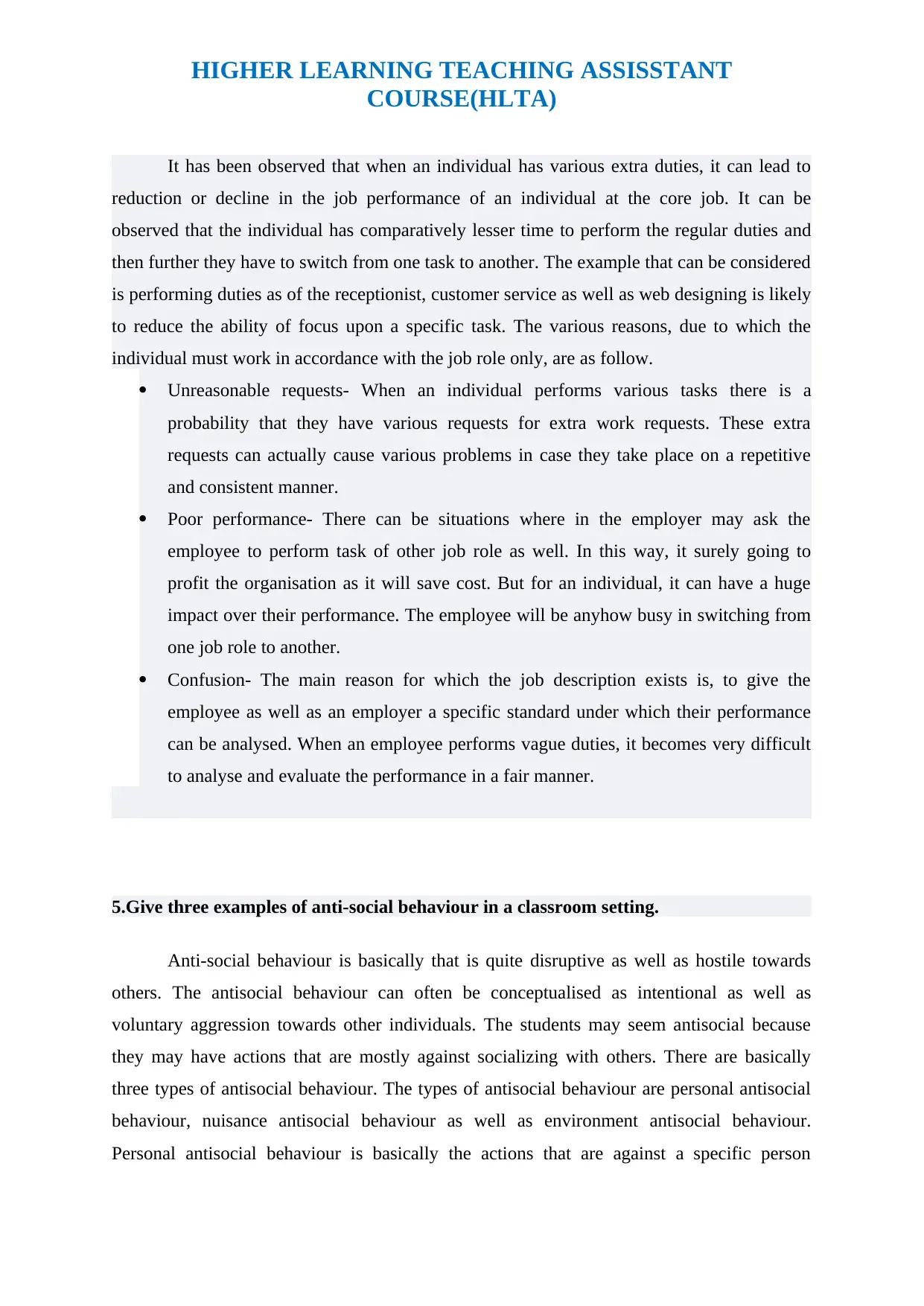
HIGHER LEARNING TEACHING ASSISSTANT
COURSE(HLTA)
It has been observed that when an individual has various extra duties, it can lead to
reduction or decline in the job performance of an individual at the core job. It can be
observed that the individual has comparatively lesser time to perform the regular duties and
then further they have to switch from one task to another. The example that can be considered
is performing duties as of the receptionist, customer service as well as web designing is likely
to reduce the ability of focus upon a specific task. The various reasons, due to which the
individual must work in accordance with the job role only, are as follow.
Unreasonable requests- When an individual performs various tasks there is a
probability that they have various requests for extra work requests. These extra
requests can actually cause various problems in case they take place on a repetitive
and consistent manner.
Poor performance- There can be situations where in the employer may ask the
employee to perform task of other job role as well. In this way, it surely going to
profit the organisation as it will save cost. But for an individual, it can have a huge
impact over their performance. The employee will be anyhow busy in switching from
one job role to another.
Confusion- The main reason for which the job description exists is, to give the
employee as well as an employer a specific standard under which their performance
can be analysed. When an employee performs vague duties, it becomes very difficult
to analyse and evaluate the performance in a fair manner.
5.Give three examples of anti-social behaviour in a classroom setting.
Anti-social behaviour is basically that is quite disruptive as well as hostile towards
others. The antisocial behaviour can often be conceptualised as intentional as well as
voluntary aggression towards other individuals. The students may seem antisocial because
they may have actions that are mostly against socializing with others. There are basically
three types of antisocial behaviour. The types of antisocial behaviour are personal antisocial
behaviour, nuisance antisocial behaviour as well as environment antisocial behaviour.
Personal antisocial behaviour is basically the actions that are against a specific person
COURSE(HLTA)
It has been observed that when an individual has various extra duties, it can lead to
reduction or decline in the job performance of an individual at the core job. It can be
observed that the individual has comparatively lesser time to perform the regular duties and
then further they have to switch from one task to another. The example that can be considered
is performing duties as of the receptionist, customer service as well as web designing is likely
to reduce the ability of focus upon a specific task. The various reasons, due to which the
individual must work in accordance with the job role only, are as follow.
Unreasonable requests- When an individual performs various tasks there is a
probability that they have various requests for extra work requests. These extra
requests can actually cause various problems in case they take place on a repetitive
and consistent manner.
Poor performance- There can be situations where in the employer may ask the
employee to perform task of other job role as well. In this way, it surely going to
profit the organisation as it will save cost. But for an individual, it can have a huge
impact over their performance. The employee will be anyhow busy in switching from
one job role to another.
Confusion- The main reason for which the job description exists is, to give the
employee as well as an employer a specific standard under which their performance
can be analysed. When an employee performs vague duties, it becomes very difficult
to analyse and evaluate the performance in a fair manner.
5.Give three examples of anti-social behaviour in a classroom setting.
Anti-social behaviour is basically that is quite disruptive as well as hostile towards
others. The antisocial behaviour can often be conceptualised as intentional as well as
voluntary aggression towards other individuals. The students may seem antisocial because
they may have actions that are mostly against socializing with others. There are basically
three types of antisocial behaviour. The types of antisocial behaviour are personal antisocial
behaviour, nuisance antisocial behaviour as well as environment antisocial behaviour.
Personal antisocial behaviour is basically the actions that are against a specific person
⊘ This is a preview!⊘
Do you want full access?
Subscribe today to unlock all pages.

Trusted by 1+ million students worldwide
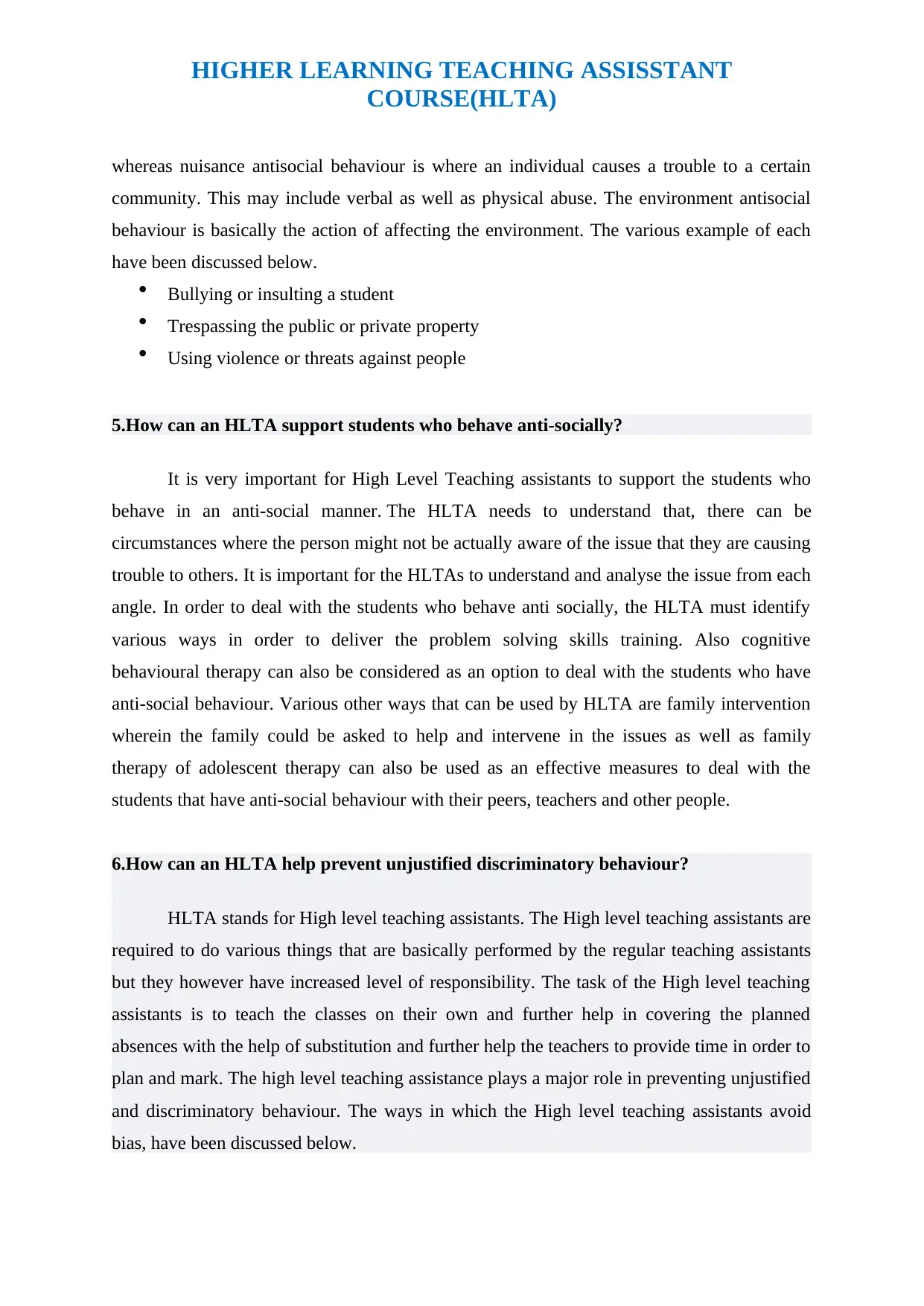
HIGHER LEARNING TEACHING ASSISSTANT
COURSE(HLTA)
whereas nuisance antisocial behaviour is where an individual causes a trouble to a certain
community. This may include verbal as well as physical abuse. The environment antisocial
behaviour is basically the action of affecting the environment. The various example of each
have been discussed below.
Bullying or insulting a student
Trespassing the public or private property
Using violence or threats against people
5.How can an HLTA support students who behave anti-socially?
It is very important for High Level Teaching assistants to support the students who
behave in an anti-social manner. The HLTA needs to understand that, there can be
circumstances where the person might not be actually aware of the issue that they are causing
trouble to others. It is important for the HLTAs to understand and analyse the issue from each
angle. In order to deal with the students who behave anti socially, the HLTA must identify
various ways in order to deliver the problem solving skills training. Also cognitive
behavioural therapy can also be considered as an option to deal with the students who have
anti-social behaviour. Various other ways that can be used by HLTA are family intervention
wherein the family could be asked to help and intervene in the issues as well as family
therapy of adolescent therapy can also be used as an effective measures to deal with the
students that have anti-social behaviour with their peers, teachers and other people.
6.How can an HLTA help prevent unjustified discriminatory behaviour?
HLTA stands for High level teaching assistants. The High level teaching assistants are
required to do various things that are basically performed by the regular teaching assistants
but they however have increased level of responsibility. The task of the High level teaching
assistants is to teach the classes on their own and further help in covering the planned
absences with the help of substitution and further help the teachers to provide time in order to
plan and mark. The high level teaching assistance plays a major role in preventing unjustified
and discriminatory behaviour. The ways in which the High level teaching assistants avoid
bias, have been discussed below.
COURSE(HLTA)
whereas nuisance antisocial behaviour is where an individual causes a trouble to a certain
community. This may include verbal as well as physical abuse. The environment antisocial
behaviour is basically the action of affecting the environment. The various example of each
have been discussed below.
Bullying or insulting a student
Trespassing the public or private property
Using violence or threats against people
5.How can an HLTA support students who behave anti-socially?
It is very important for High Level Teaching assistants to support the students who
behave in an anti-social manner. The HLTA needs to understand that, there can be
circumstances where the person might not be actually aware of the issue that they are causing
trouble to others. It is important for the HLTAs to understand and analyse the issue from each
angle. In order to deal with the students who behave anti socially, the HLTA must identify
various ways in order to deliver the problem solving skills training. Also cognitive
behavioural therapy can also be considered as an option to deal with the students who have
anti-social behaviour. Various other ways that can be used by HLTA are family intervention
wherein the family could be asked to help and intervene in the issues as well as family
therapy of adolescent therapy can also be used as an effective measures to deal with the
students that have anti-social behaviour with their peers, teachers and other people.
6.How can an HLTA help prevent unjustified discriminatory behaviour?
HLTA stands for High level teaching assistants. The High level teaching assistants are
required to do various things that are basically performed by the regular teaching assistants
but they however have increased level of responsibility. The task of the High level teaching
assistants is to teach the classes on their own and further help in covering the planned
absences with the help of substitution and further help the teachers to provide time in order to
plan and mark. The high level teaching assistance plays a major role in preventing unjustified
and discriminatory behaviour. The ways in which the High level teaching assistants avoid
bias, have been discussed below.
Paraphrase This Document
Need a fresh take? Get an instant paraphrase of this document with our AI Paraphraser
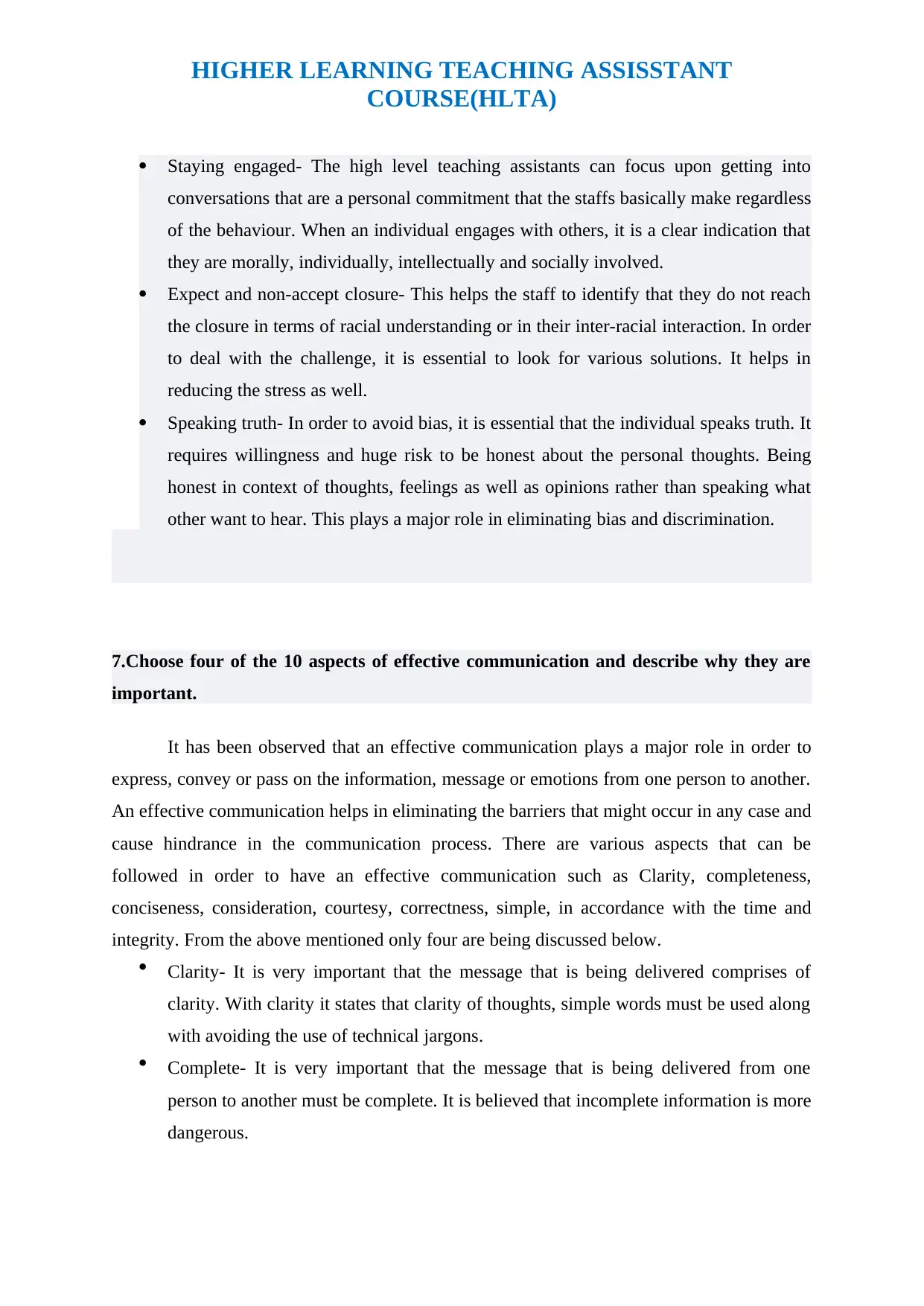
HIGHER LEARNING TEACHING ASSISSTANT
COURSE(HLTA)
Staying engaged- The high level teaching assistants can focus upon getting into
conversations that are a personal commitment that the staffs basically make regardless
of the behaviour. When an individual engages with others, it is a clear indication that
they are morally, individually, intellectually and socially involved.
Expect and non-accept closure- This helps the staff to identify that they do not reach
the closure in terms of racial understanding or in their inter-racial interaction. In order
to deal with the challenge, it is essential to look for various solutions. It helps in
reducing the stress as well.
Speaking truth- In order to avoid bias, it is essential that the individual speaks truth. It
requires willingness and huge risk to be honest about the personal thoughts. Being
honest in context of thoughts, feelings as well as opinions rather than speaking what
other want to hear. This plays a major role in eliminating bias and discrimination.
7.Choose four of the 10 aspects of effective communication and describe why they are
important.
It has been observed that an effective communication plays a major role in order to
express, convey or pass on the information, message or emotions from one person to another.
An effective communication helps in eliminating the barriers that might occur in any case and
cause hindrance in the communication process. There are various aspects that can be
followed in order to have an effective communication such as Clarity, completeness,
conciseness, consideration, courtesy, correctness, simple, in accordance with the time and
integrity. From the above mentioned only four are being discussed below.
Clarity- It is very important that the message that is being delivered comprises of
clarity. With clarity it states that clarity of thoughts, simple words must be used along
with avoiding the use of technical jargons.
Complete- It is very important that the message that is being delivered from one
person to another must be complete. It is believed that incomplete information is more
dangerous.
COURSE(HLTA)
Staying engaged- The high level teaching assistants can focus upon getting into
conversations that are a personal commitment that the staffs basically make regardless
of the behaviour. When an individual engages with others, it is a clear indication that
they are morally, individually, intellectually and socially involved.
Expect and non-accept closure- This helps the staff to identify that they do not reach
the closure in terms of racial understanding or in their inter-racial interaction. In order
to deal with the challenge, it is essential to look for various solutions. It helps in
reducing the stress as well.
Speaking truth- In order to avoid bias, it is essential that the individual speaks truth. It
requires willingness and huge risk to be honest about the personal thoughts. Being
honest in context of thoughts, feelings as well as opinions rather than speaking what
other want to hear. This plays a major role in eliminating bias and discrimination.
7.Choose four of the 10 aspects of effective communication and describe why they are
important.
It has been observed that an effective communication plays a major role in order to
express, convey or pass on the information, message or emotions from one person to another.
An effective communication helps in eliminating the barriers that might occur in any case and
cause hindrance in the communication process. There are various aspects that can be
followed in order to have an effective communication such as Clarity, completeness,
conciseness, consideration, courtesy, correctness, simple, in accordance with the time and
integrity. From the above mentioned only four are being discussed below.
Clarity- It is very important that the message that is being delivered comprises of
clarity. With clarity it states that clarity of thoughts, simple words must be used along
with avoiding the use of technical jargons.
Complete- It is very important that the message that is being delivered from one
person to another must be complete. It is believed that incomplete information is more
dangerous.
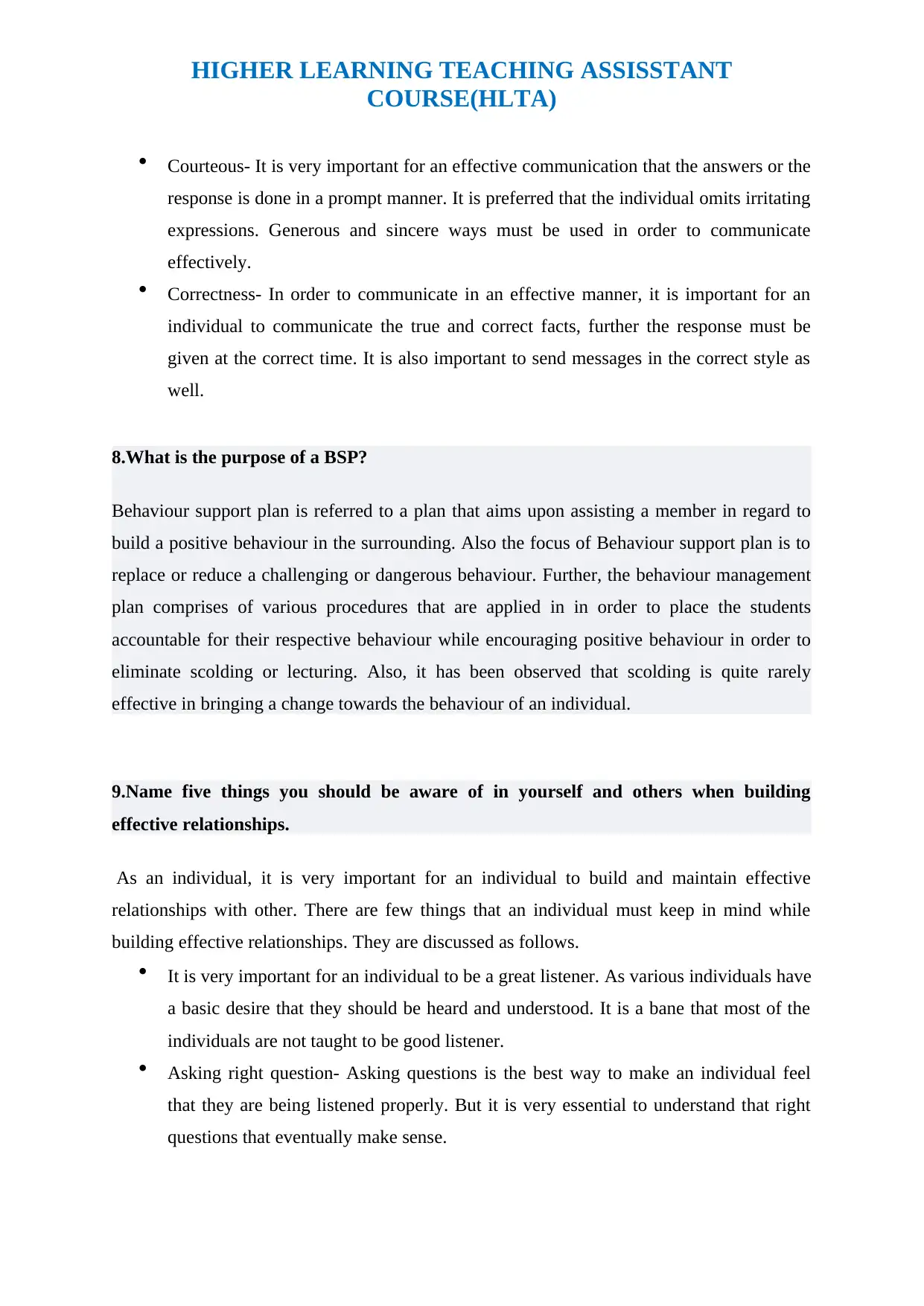
HIGHER LEARNING TEACHING ASSISSTANT
COURSE(HLTA)
Courteous- It is very important for an effective communication that the answers or the
response is done in a prompt manner. It is preferred that the individual omits irritating
expressions. Generous and sincere ways must be used in order to communicate
effectively.
Correctness- In order to communicate in an effective manner, it is important for an
individual to communicate the true and correct facts, further the response must be
given at the correct time. It is also important to send messages in the correct style as
well.
8.What is the purpose of a BSP?
Behaviour support plan is referred to a plan that aims upon assisting a member in regard to
build a positive behaviour in the surrounding. Also the focus of Behaviour support plan is to
replace or reduce a challenging or dangerous behaviour. Further, the behaviour management
plan comprises of various procedures that are applied in in order to place the students
accountable for their respective behaviour while encouraging positive behaviour in order to
eliminate scolding or lecturing. Also, it has been observed that scolding is quite rarely
effective in bringing a change towards the behaviour of an individual.
9.Name five things you should be aware of in yourself and others when building
effective relationships.
As an individual, it is very important for an individual to build and maintain effective
relationships with other. There are few things that an individual must keep in mind while
building effective relationships. They are discussed as follows.
It is very important for an individual to be a great listener. As various individuals have
a basic desire that they should be heard and understood. It is a bane that most of the
individuals are not taught to be good listener.
Asking right question- Asking questions is the best way to make an individual feel
that they are being listened properly. But it is very essential to understand that right
questions that eventually make sense.
COURSE(HLTA)
Courteous- It is very important for an effective communication that the answers or the
response is done in a prompt manner. It is preferred that the individual omits irritating
expressions. Generous and sincere ways must be used in order to communicate
effectively.
Correctness- In order to communicate in an effective manner, it is important for an
individual to communicate the true and correct facts, further the response must be
given at the correct time. It is also important to send messages in the correct style as
well.
8.What is the purpose of a BSP?
Behaviour support plan is referred to a plan that aims upon assisting a member in regard to
build a positive behaviour in the surrounding. Also the focus of Behaviour support plan is to
replace or reduce a challenging or dangerous behaviour. Further, the behaviour management
plan comprises of various procedures that are applied in in order to place the students
accountable for their respective behaviour while encouraging positive behaviour in order to
eliminate scolding or lecturing. Also, it has been observed that scolding is quite rarely
effective in bringing a change towards the behaviour of an individual.
9.Name five things you should be aware of in yourself and others when building
effective relationships.
As an individual, it is very important for an individual to build and maintain effective
relationships with other. There are few things that an individual must keep in mind while
building effective relationships. They are discussed as follows.
It is very important for an individual to be a great listener. As various individuals have
a basic desire that they should be heard and understood. It is a bane that most of the
individuals are not taught to be good listener.
Asking right question- Asking questions is the best way to make an individual feel
that they are being listened properly. But it is very essential to understand that right
questions that eventually make sense.
⊘ This is a preview!⊘
Do you want full access?
Subscribe today to unlock all pages.

Trusted by 1+ million students worldwide
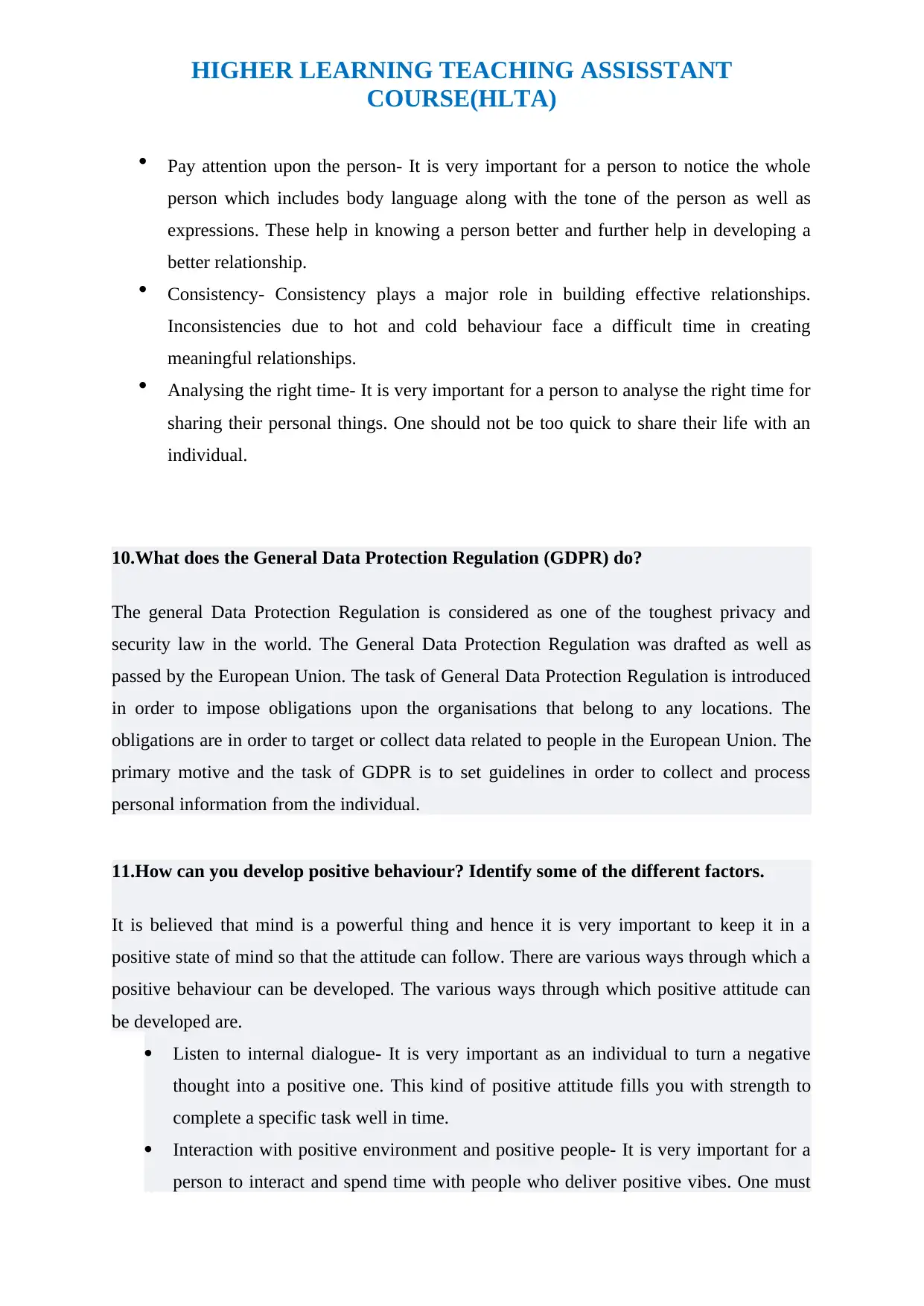
HIGHER LEARNING TEACHING ASSISSTANT
COURSE(HLTA)
Pay attention upon the person- It is very important for a person to notice the whole
person which includes body language along with the tone of the person as well as
expressions. These help in knowing a person better and further help in developing a
better relationship.
Consistency- Consistency plays a major role in building effective relationships.
Inconsistencies due to hot and cold behaviour face a difficult time in creating
meaningful relationships.
Analysing the right time- It is very important for a person to analyse the right time for
sharing their personal things. One should not be too quick to share their life with an
individual.
10.What does the General Data Protection Regulation (GDPR) do?
The general Data Protection Regulation is considered as one of the toughest privacy and
security law in the world. The General Data Protection Regulation was drafted as well as
passed by the European Union. The task of General Data Protection Regulation is introduced
in order to impose obligations upon the organisations that belong to any locations. The
obligations are in order to target or collect data related to people in the European Union. The
primary motive and the task of GDPR is to set guidelines in order to collect and process
personal information from the individual.
11.How can you develop positive behaviour? Identify some of the different factors.
It is believed that mind is a powerful thing and hence it is very important to keep it in a
positive state of mind so that the attitude can follow. There are various ways through which a
positive behaviour can be developed. The various ways through which positive attitude can
be developed are.
Listen to internal dialogue- It is very important as an individual to turn a negative
thought into a positive one. This kind of positive attitude fills you with strength to
complete a specific task well in time.
Interaction with positive environment and positive people- It is very important for a
person to interact and spend time with people who deliver positive vibes. One must
COURSE(HLTA)
Pay attention upon the person- It is very important for a person to notice the whole
person which includes body language along with the tone of the person as well as
expressions. These help in knowing a person better and further help in developing a
better relationship.
Consistency- Consistency plays a major role in building effective relationships.
Inconsistencies due to hot and cold behaviour face a difficult time in creating
meaningful relationships.
Analysing the right time- It is very important for a person to analyse the right time for
sharing their personal things. One should not be too quick to share their life with an
individual.
10.What does the General Data Protection Regulation (GDPR) do?
The general Data Protection Regulation is considered as one of the toughest privacy and
security law in the world. The General Data Protection Regulation was drafted as well as
passed by the European Union. The task of General Data Protection Regulation is introduced
in order to impose obligations upon the organisations that belong to any locations. The
obligations are in order to target or collect data related to people in the European Union. The
primary motive and the task of GDPR is to set guidelines in order to collect and process
personal information from the individual.
11.How can you develop positive behaviour? Identify some of the different factors.
It is believed that mind is a powerful thing and hence it is very important to keep it in a
positive state of mind so that the attitude can follow. There are various ways through which a
positive behaviour can be developed. The various ways through which positive attitude can
be developed are.
Listen to internal dialogue- It is very important as an individual to turn a negative
thought into a positive one. This kind of positive attitude fills you with strength to
complete a specific task well in time.
Interaction with positive environment and positive people- It is very important for a
person to interact and spend time with people who deliver positive vibes. One must
Paraphrase This Document
Need a fresh take? Get an instant paraphrase of this document with our AI Paraphraser
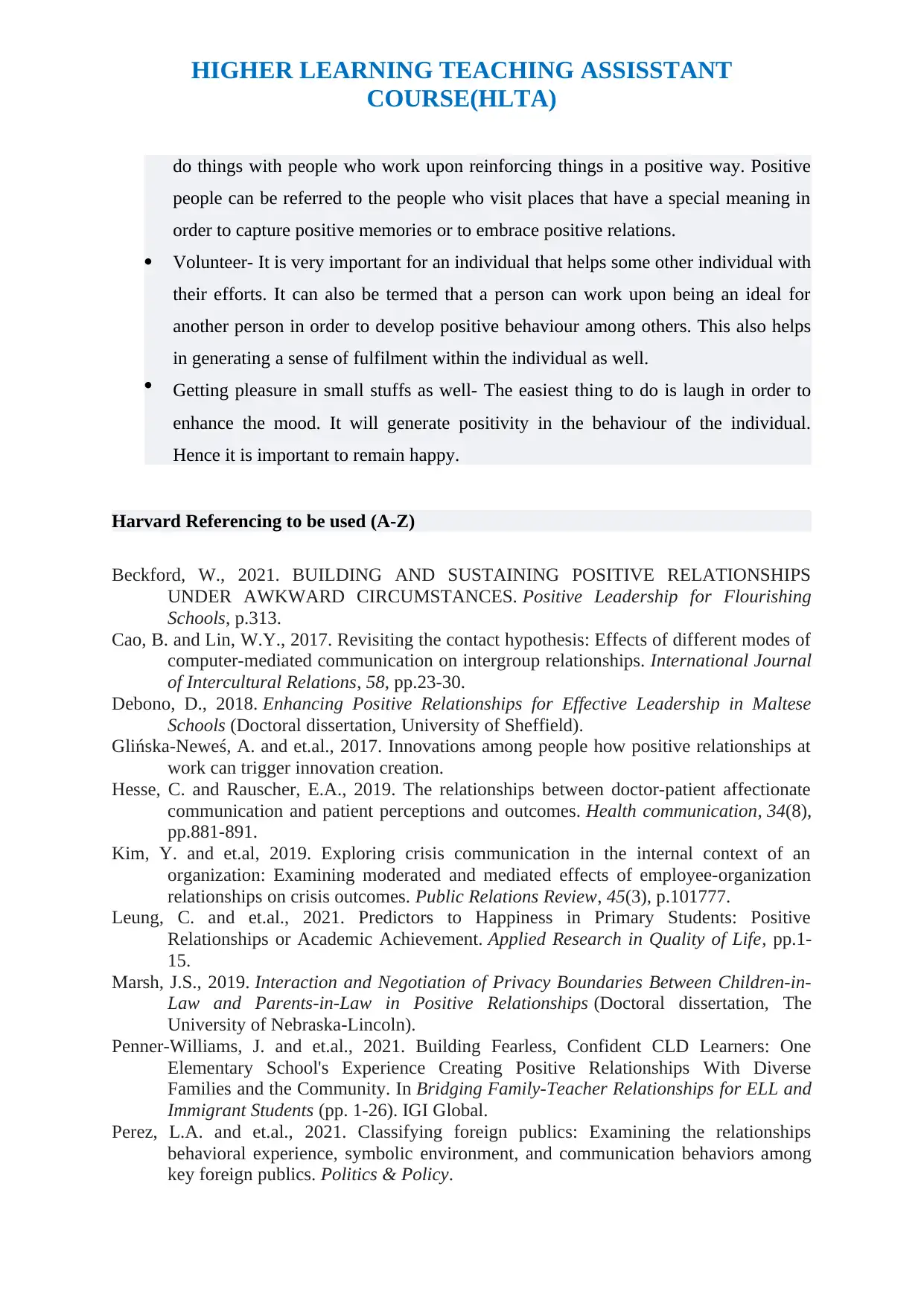
HIGHER LEARNING TEACHING ASSISSTANT
COURSE(HLTA)
do things with people who work upon reinforcing things in a positive way. Positive
people can be referred to the people who visit places that have a special meaning in
order to capture positive memories or to embrace positive relations.
Volunteer- It is very important for an individual that helps some other individual with
their efforts. It can also be termed that a person can work upon being an ideal for
another person in order to develop positive behaviour among others. This also helps
in generating a sense of fulfilment within the individual as well.
Getting pleasure in small stuffs as well- The easiest thing to do is laugh in order to
enhance the mood. It will generate positivity in the behaviour of the individual.
Hence it is important to remain happy.
Harvard Referencing to be used (A-Z)
Beckford, W., 2021. BUILDING AND SUSTAINING POSITIVE RELATIONSHIPS
UNDER AWKWARD CIRCUMSTANCES. Positive Leadership for Flourishing
Schools, p.313.
Cao, B. and Lin, W.Y., 2017. Revisiting the contact hypothesis: Effects of different modes of
computer-mediated communication on intergroup relationships. International Journal
of Intercultural Relations, 58, pp.23-30.
Debono, D., 2018. Enhancing Positive Relationships for Effective Leadership in Maltese
Schools (Doctoral dissertation, University of Sheffield).
Glińska-Neweś, A. and et.al., 2017. Innovations among people how positive relationships at
work can trigger innovation creation.
Hesse, C. and Rauscher, E.A., 2019. The relationships between doctor-patient affectionate
communication and patient perceptions and outcomes. Health communication, 34(8),
pp.881-891.
Kim, Y. and et.al, 2019. Exploring crisis communication in the internal context of an
organization: Examining moderated and mediated effects of employee-organization
relationships on crisis outcomes. Public Relations Review, 45(3), p.101777.
Leung, C. and et.al., 2021. Predictors to Happiness in Primary Students: Positive
Relationships or Academic Achievement. Applied Research in Quality of Life, pp.1-
15.
Marsh, J.S., 2019. Interaction and Negotiation of Privacy Boundaries Between Children-in-
Law and Parents-in-Law in Positive Relationships (Doctoral dissertation, The
University of Nebraska-Lincoln).
Penner-Williams, J. and et.al., 2021. Building Fearless, Confident CLD Learners: One
Elementary School's Experience Creating Positive Relationships With Diverse
Families and the Community. In Bridging Family-Teacher Relationships for ELL and
Immigrant Students (pp. 1-26). IGI Global.
Perez, L.A. and et.al., 2021. Classifying foreign publics: Examining the relationships
behavioral experience, symbolic environment, and communication behaviors among
key foreign publics. Politics & Policy.
COURSE(HLTA)
do things with people who work upon reinforcing things in a positive way. Positive
people can be referred to the people who visit places that have a special meaning in
order to capture positive memories or to embrace positive relations.
Volunteer- It is very important for an individual that helps some other individual with
their efforts. It can also be termed that a person can work upon being an ideal for
another person in order to develop positive behaviour among others. This also helps
in generating a sense of fulfilment within the individual as well.
Getting pleasure in small stuffs as well- The easiest thing to do is laugh in order to
enhance the mood. It will generate positivity in the behaviour of the individual.
Hence it is important to remain happy.
Harvard Referencing to be used (A-Z)
Beckford, W., 2021. BUILDING AND SUSTAINING POSITIVE RELATIONSHIPS
UNDER AWKWARD CIRCUMSTANCES. Positive Leadership for Flourishing
Schools, p.313.
Cao, B. and Lin, W.Y., 2017. Revisiting the contact hypothesis: Effects of different modes of
computer-mediated communication on intergroup relationships. International Journal
of Intercultural Relations, 58, pp.23-30.
Debono, D., 2018. Enhancing Positive Relationships for Effective Leadership in Maltese
Schools (Doctoral dissertation, University of Sheffield).
Glińska-Neweś, A. and et.al., 2017. Innovations among people how positive relationships at
work can trigger innovation creation.
Hesse, C. and Rauscher, E.A., 2019. The relationships between doctor-patient affectionate
communication and patient perceptions and outcomes. Health communication, 34(8),
pp.881-891.
Kim, Y. and et.al, 2019. Exploring crisis communication in the internal context of an
organization: Examining moderated and mediated effects of employee-organization
relationships on crisis outcomes. Public Relations Review, 45(3), p.101777.
Leung, C. and et.al., 2021. Predictors to Happiness in Primary Students: Positive
Relationships or Academic Achievement. Applied Research in Quality of Life, pp.1-
15.
Marsh, J.S., 2019. Interaction and Negotiation of Privacy Boundaries Between Children-in-
Law and Parents-in-Law in Positive Relationships (Doctoral dissertation, The
University of Nebraska-Lincoln).
Penner-Williams, J. and et.al., 2021. Building Fearless, Confident CLD Learners: One
Elementary School's Experience Creating Positive Relationships With Diverse
Families and the Community. In Bridging Family-Teacher Relationships for ELL and
Immigrant Students (pp. 1-26). IGI Global.
Perez, L.A. and et.al., 2021. Classifying foreign publics: Examining the relationships
behavioral experience, symbolic environment, and communication behaviors among
key foreign publics. Politics & Policy.
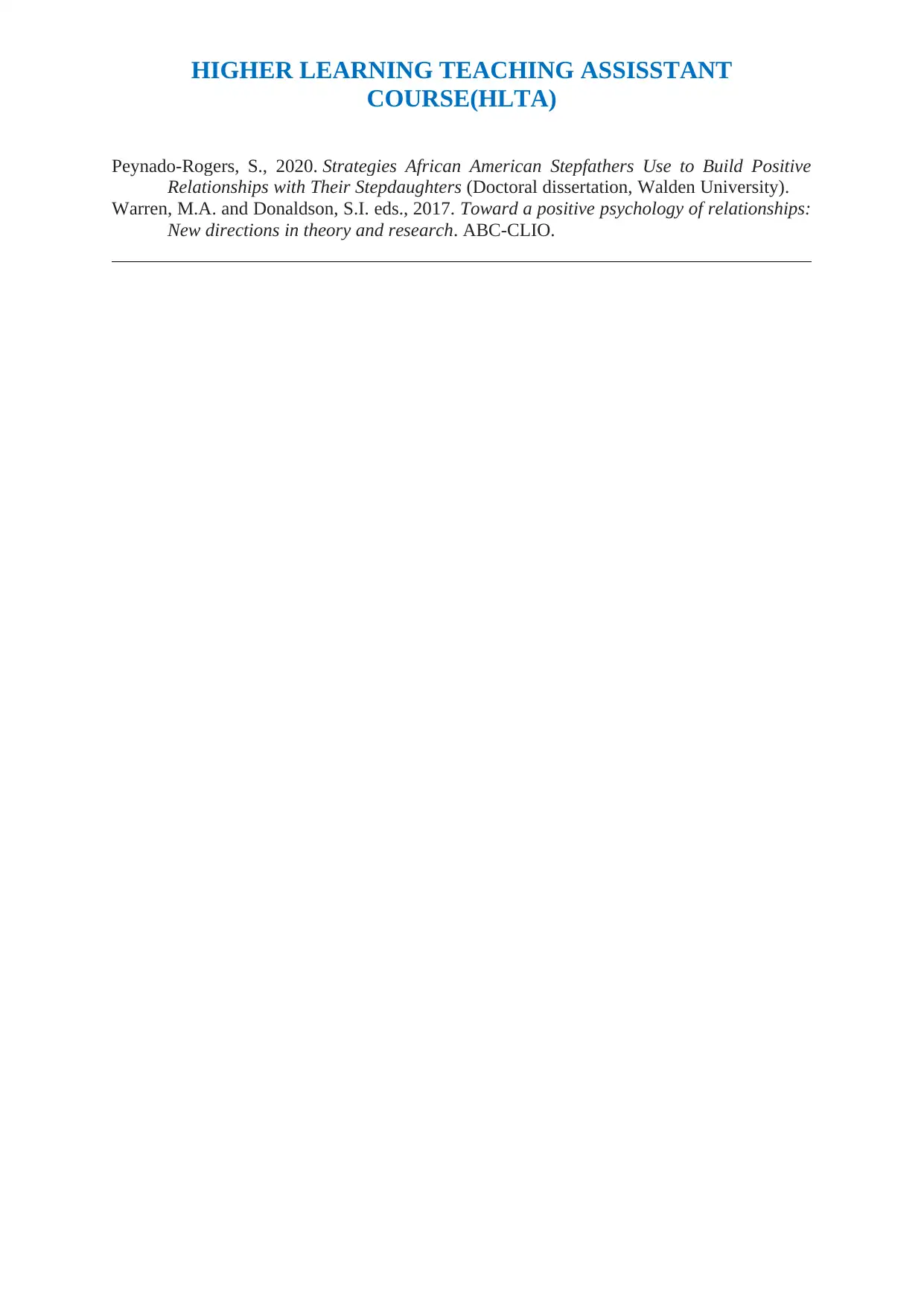
HIGHER LEARNING TEACHING ASSISSTANT
COURSE(HLTA)
Peynado-Rogers, S., 2020. Strategies African American Stepfathers Use to Build Positive
Relationships with Their Stepdaughters (Doctoral dissertation, Walden University).
Warren, M.A. and Donaldson, S.I. eds., 2017. Toward a positive psychology of relationships:
New directions in theory and research. ABC-CLIO.
COURSE(HLTA)
Peynado-Rogers, S., 2020. Strategies African American Stepfathers Use to Build Positive
Relationships with Their Stepdaughters (Doctoral dissertation, Walden University).
Warren, M.A. and Donaldson, S.I. eds., 2017. Toward a positive psychology of relationships:
New directions in theory and research. ABC-CLIO.
⊘ This is a preview!⊘
Do you want full access?
Subscribe today to unlock all pages.

Trusted by 1+ million students worldwide
1 out of 9
Related Documents
Your All-in-One AI-Powered Toolkit for Academic Success.
+13062052269
info@desklib.com
Available 24*7 on WhatsApp / Email
![[object Object]](/_next/static/media/star-bottom.7253800d.svg)
Unlock your academic potential
Copyright © 2020–2025 A2Z Services. All Rights Reserved. Developed and managed by ZUCOL.





